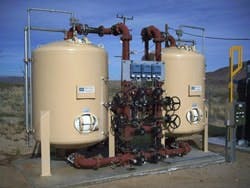The Twentynine Palms Water District serves a population of approximately 17,000 through a system of nine potable wells. The system comprises 7,600 water meters, with about 95% of them residential. Like many water systems in Southern California, the water district uses equipment to remove fluoride from its water to comply with the state mandate of fluoride levels less than 2 mg/L. The district uses a 3-million-gal-per-day (gpd) activated alumina fluoride removal system—the largest of its kind in the U.S. Chlorine is also added to the water supply at each of the nine well sites.
Arsenic, commonly found in many western states’ groundwater, was also present in the wells, with levels ranging from undetected to 12 parts per billion (ppb) in eight of them. However, in the ninth, a 30-year-old well, arsenic levels averaged 19 ppb.
When Wright was investigating an arsenic removal solution, he consulted with the State Department of Health Services, the state agency responsible for enforcing the California Environmental Quality Act (CEQA). Wright’s goal was to comply with CEQA standards as cost effectively as possible. By creating a closed-loop system where media backwash water was recovered and recycled, Wright realized he could create significant savings opportunities for the city by using a solution that was not bound to CEQA standards.
After investigating several arsenic removal systems, the district selected the SORB system with Bayoxide media. “We wanted a reliable system,” said Wright, “and our additional considerations were capital costs, waste handling and operations and maintenance. With several wells scattered throughout our service area, we needed a system that would be practical for small well applications. The closed-loop system allowed for very simple construction, compliance with the regulatory agencies and ensured low O&M costs.”
Severn Trent Services provided two 5-ft SORB 33 adsorption vessels for the arsenic removal system. The system’s footprint measured 14 ft (L) x 7 ft (W) x 10 ft (H). Each adsorption vessel has a design flow rate of 130 gal per minute (gpm). The water district is using each vessel to its full capacity to treat 260 gpm of the well’s 325-gpm capacity and is bypassing 65 gpm.
The system was designed with a backwash recovery zero discharge system so that water produced during the backwash process is returned to the head of the treatment system and run through the media. The backwash/rinse wastewater holding tank has a capacity of 3,200 gal.
Based on a review of water quality provided by the water district, Severn Trent Services guaranteed 118,000 bed volumes or the equivalent of 121.9 million gal of usage from the media before changeout was required. The company estimated that the media installed in September 2007 would be exhausted in September 2009.
Severn Trent Services representatives said the SORB system operates most efficiently when the feed water’s ambient pH is in the range of 7.0 to 7.5. While water from the water district’s well had a pH of 7.9, the SORB system has been working extremely well without any pH treatment.
Wright had been told that backwashing would be needed every three months. “But the system has been in operation since September 2007 and as of July 2008, the pressure increase over the media bed has not required that we backwash yet. So far, the system is exceeding our expectations and is operating very well. Arsenic in the water treated by the SORB system measures 0 ppb, and when effluent from the two vessels is combined with the raw bypass water, arsenic levels average about 3.4 ppb.
“An additional positive feature of our closed-loop SORB system is that it can be easily retrofitted to accept more flow just by adding additional vessels and some piping. As a matter of fact, we’re planning just such a retrofit of our system in the near future,” Wright said.
| Related Searches from WaterInfoLink.com Arsenic Removal | Arsenic | Twentynine Palms Water District | California Environmental Quality Act | Severn Trent Services |
